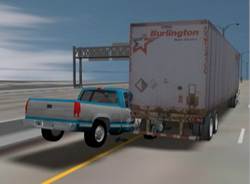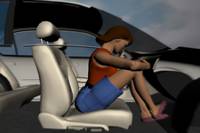|
3 Collisions
in Every Crash
When a vehicle collides
with something, the crash is comprised of 3 collisions.
Lets go over these collisions and how seatbelts and other
restraints operate to distribute their effect.
 Vehicle
Collision Vehicle
Collision
The first collision is when the vehicle strikes another
vehicle or object. In a frontal collision, the bumper
to the beginning of the passenger compartment absorbs
some of the impact and dissipates it as energy by bending
of metal and crushing of other components. The front of
vehicles are designed to crush and absorb as much energy
as possible to there is less force the occupants must
absorb.
 Occupant
Collision Occupant
Collision
The next collision is between the
occupants and the interior of the vehicle or restraints.
When the initial impact occurs the occupants are still
traveling forward the same speed the vehicle was traveling
prior to the collision. When unbelted, passengers will
slam into the dash, windshield or other occupants.
 Internal
Collision Internal
Collision
An occupant's internal organs keep
moving, even after the occupant's body comes to a complete
stop. Just like the occupants hitting the interior of
the car, your organs collide with bone and other organs.
This is the most serious collision and many times causes
very serious or fatal injuries.
During a crash, safety
belts distribute the forces of a collision over larger and
stronger parts of the person's body. The belts also stretch
and spread the force over a longer period of time. This
significantly reduces the severity of internal collisions
and prevents or reduces occupant collisions.
|